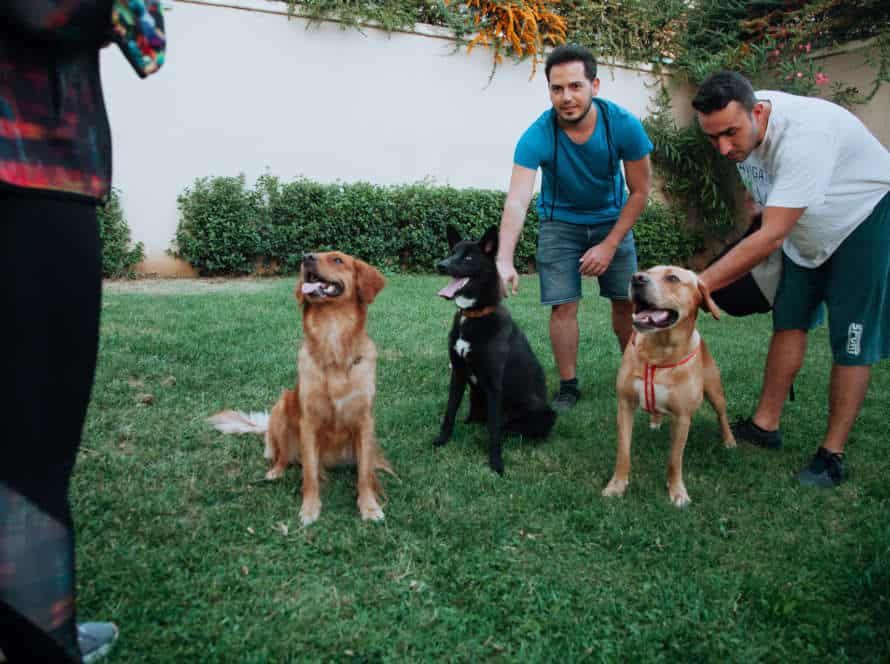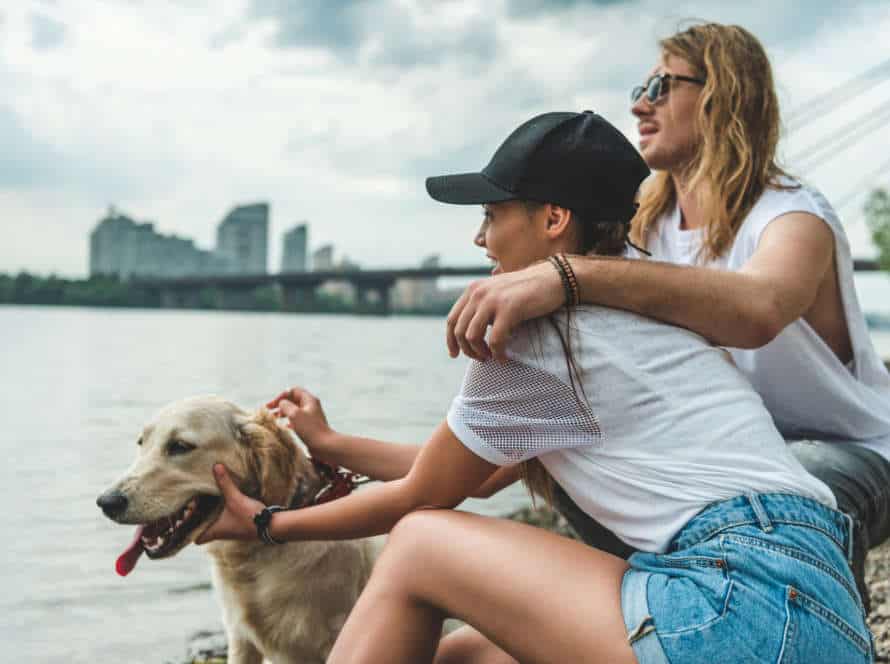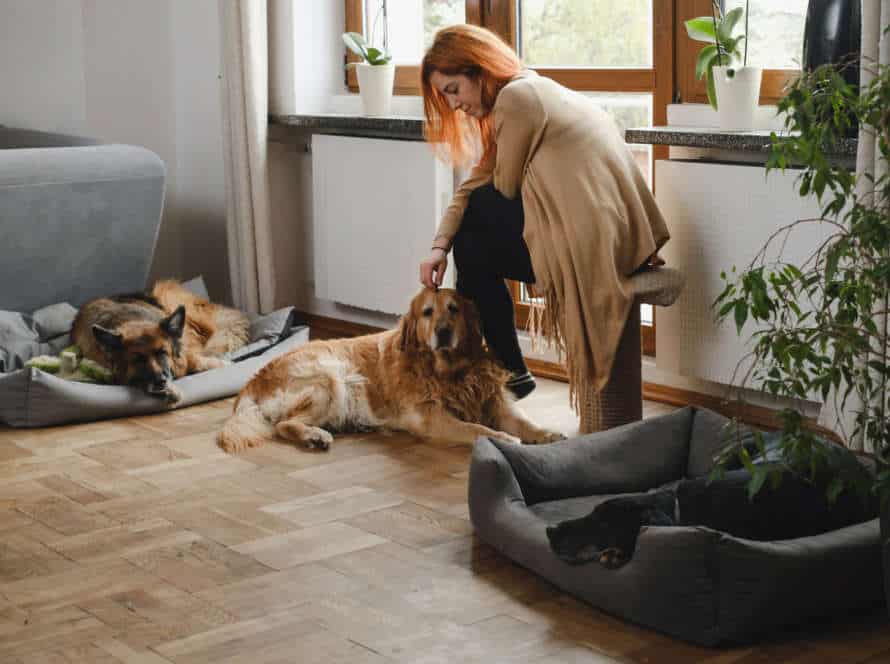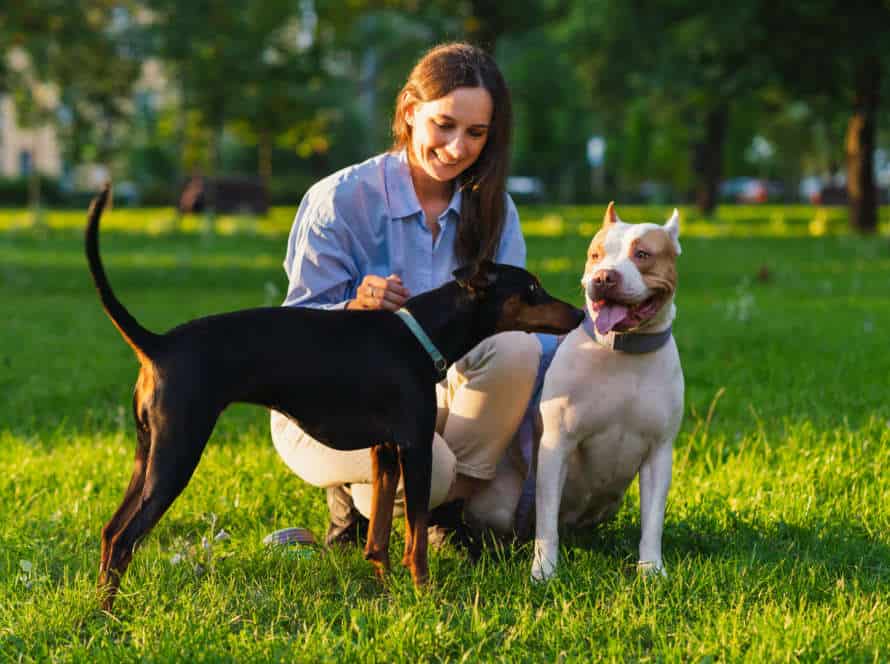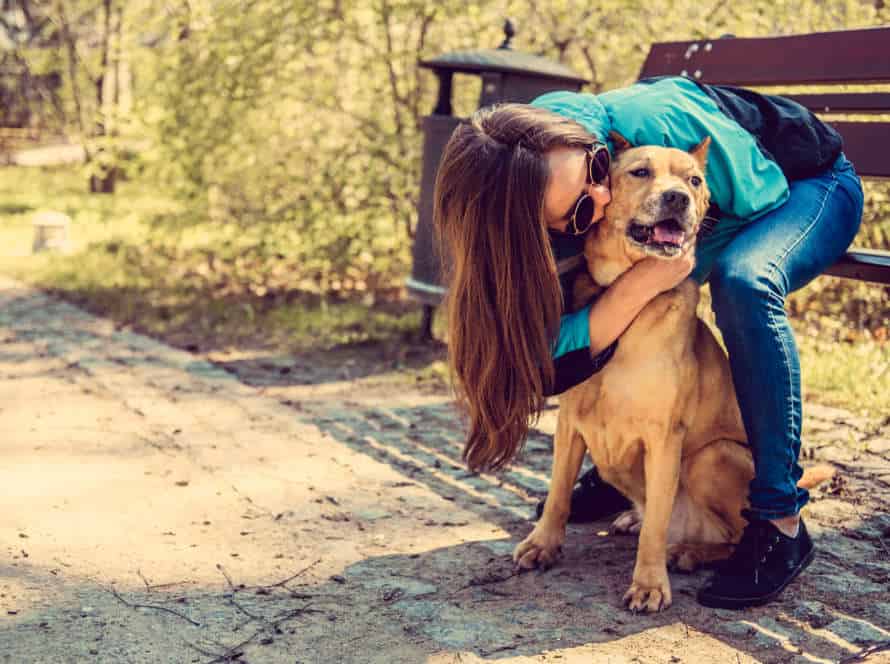Overcoming Common Dog Fears: Tips and Techniques
Dog fears are common for many pet owners. To look after the well-being of your pup and yourself, it’s important to understand and tackle these issues. Here are helpful tips to help your dog overcome its fears:
- Socialization: Proper socialization can help your pup get used to other dogs and people.
- Positive reinforcement: Use praise and treats to desensitize your pup to fearful situations.
- Gradual exposure: Introduce your pup to its fear triggers slowly, and in increasing amounts.
- Professional training: A professional dog trainer can teach your pup coping mechanisms and techniques.
- Exercise & stimulation: Keep your pup active and mentally stimulated to reduce anxiety and promote relaxation.
By following these tips, you can help your pooch beat its fears and live a happy, healthy life.
Fear of Dogs
Fearing dogs is a worry many pups have. It can leave them feeling anxious, stressed, or even aggressive. Fortunately, pet owners can help their pup overcome this challenge. Here are some tips and techniques that can be used to help them:
- Build trust
- Introduce new things
- Explore new environments
With these steps, you can help your pup overcome their fear of dogs.
Understand dog body language
It’s key to know how to read dog body language. Dogs express feelings and intentions through body signals. Knowing them will make you feel safe around pups.
Here are some common ones:
- Tail – A wagging tail means a happy pup. A tucked tail? Fear or aggression.
- Eyes – Direct eye contact can be aggressive. Relaxed eyes? Calm pup.
- Ears – Raised ears mean alertness or aggression. Lowered ears – fear or submission.
- Mouth – Bared teeth, growling or snarling is aggression. Relaxed open mouth? Calm pup.
- Posture – Raised hackles and a stiff posture? Aggression. Lowered body position? Fear or submission.
By understanding a dog’s body language, you can get a better sense of their emotions and intentions. This will help you feel more secure around them.
Start with smaller and non-barking dogs
If you have a fear of dogs, you can begin with small, non-barking ones. This can help you conquer your fear and gain confidence. Here are some tips:
- Stand in a safe spot and watch them play with their owners.
- Ask the owner if you can pet the dog. Then slowly go up to it and pet it with their guidance.
- Meet the dog on an unfamiliar place. Not its own space.
- Do deep breaths and relaxation techniques to control your apprehension.
- If your fear is strong and affecting your life, seek professional help.
Remember, dogs sense fear and uneasiness. So stay calm when you come near them. Pro Tip: Reward yourself after every successful encounter to create positive feelings.
Take small steps to exposure
Afraid of dogs? Taking small steps can help you conquer your fear and form a better relationship with man’s best pal. Here are some tips to get you started:
- Look at pics or watch videos of dogs. Then, start observing them from a distance in places like parks or other public spots.
- Interact with a trained therapy dog, with the guidance of a professional handler.
- Take an obedience or training class with a pro dog trainer. This will help you build your confidence and learn how to communicate with canines in a safe way.
Remember: it’s important to face your fear, but never put yourself in any dangerous situation. Prioritize safety and ask for help if needed.
Pro tip: Exposure therapy takes time and patience, but with the right attitude and help, you can beat your fear of dogs.
Fear of Dog Bites
Fear of dog bites is one of the most common fears people have of dogs. Overcoming it can be hard, especially if you have been bitten by a dog before. So, how do you help your dog get over this fear? Here, we will look at techniques and tips to help your dog conquer his fear of bites.
Start training at an early age
Beating common fears of dog bites and connecting with dogs safely starts when you train them early. Focus on boosting their confidence and teaching basic commands to comprehend their behavior. Here are some ideas to follow:
- Begin with puppies as they are less intimidating and usually do not show aggression.
- Teach basic instructions like “sit”, “stay” or “no” for better control.
- Look for signs of fear, stress or aggression like growling, barking, stiff body and rolled lips.
Training with patience, consistency and positive reinforcement is essential for a great bond. This will make your interactions with your pup much more enjoyable. Remember to train children from an early age too. Parents should always be present when introducing kids to dogs – even if it’s a well-trained dog.
Teach your dog obedience and good behavior
Teaching your pup obedience and good behavior is important for avoiding common dog worries, such as bites. Here are some tips and tricks to help your furry friend be a well-mannered and obedient companion:
- Begin with basic commands like “sit”, “stay”, “come”, and “leave it”.
- Use positive reinforcement like treats, compliments, and toys to reward good behavior and discourage bad behavior.
- Expose your pup to different people, places, and animals to socialize them. This helps them feel more comfortable in various circumstances.
- Be steady in your training and create a routine for your pup.
- Ask for the help of a professional trainer if you need it.
By training your pup obedience and good behavior, you can stop common dog worries, including bites, and build a strong connection with your furry friend.
Pro tip: Regular training times and exercise can help reduce anxieties and stress in dogs, resulting in improved behavior and overall health.
Learn appropriate responses to dog behavior
It’s critical to comprehend and respond suitably to canine behavior to stop dog bites and get over common canine fears. Here are some suitable responses to typical canine behavior:
Barking: Dogs may bark to communicate or express their emotions. Give the pup room and stay away from making direct eye contact. Talk calmly and attempt to divert their attention using toys or treats.
Growling: Growling is usually a warning sign that the dog feels threatened or uneasy. Don’t approach or touch the pup and give them room. Talk calmly and avoid direct eye contact.
Jumping: Pups often jump to show their excitement or welcome people. Don’t push or punish the dog as it might raise their excitement level. Instead, turn away and avoid eye contact until the pup calms down.
Pro tip: Always ask the dog owner’s permission before approaching or petting a pup. Respect the pup’s boundaries and body language for a secure and cheerful interaction.
Fear of Aggressive Dogs
Dogs often fear aggressive dogs. This can lead to various problems such as aggression towards other dogs, cowering, and averting eye contact. Thankfully, there are tips and techniques that can aid owners in helping their pup with this fear. Here are some strategies and how they can help fearful dogs feel safe around other animals.
Recognize and avoid risky situations
Beating a fear of aggressive dogs? Here are the tips to do it:
- Watch the dog’s body language. If it’s growling, barking, or has ears back, stay away.
- Don’t stare at it.
- Move away calmly, without any sudden movements.
- Bring a deterrent if you’re in a risky area.
- Take a self-defense course for extra confidence.
Remember, not all dogs are aggressive. Most are friendly.
Use positive reinforcement training
Positive reinforcement training is a great way to tackle your fear of aggressive dogs. It uses rewards and encouragement to teach the pup what behavior is desired, not punishment for bad behavior. Here are some tips to help you:
- Start small – pics and videos of dogs first. Then dogs from a distance. Eventually, up-close encounters.
- Offer treats and praise for good behavior, like calmness.
- Speak in a calm and assertive tone.
- Don’t make direct eye contact – it could be seen as a threat.
With time, patience, and practice, positive reinforcement training can help you build a better relationship with aggressive dogs. Pro Tip: Get help from an experienced dog trainer or behaviorist for safety.
Find a professional dog trainer or behaviorist
Finding a pro dog trainer or behaviorist can be a great way to beat the fear of aggressive dogs. These specialists are trained to help pups & owners with a variety of behavioral issues. Here are some tips for finding the right pro for your needs:
- Do your research. Look for certified trainers & behaviorists near you & read reviews & testimonials.
- Visit the facility. Book a visit to the trainer or behaviorist’s spot to get a sense of their methods & ideas.
- Ask for referrals. Talk to other dog owners & your vet for advice on reliable trainers & behaviorists.
- Ask questions. Before saying yes to a trainer or behaviorist, ask about their training methods, experience & success rate.
- Remember that conquering a fear of aggressive dogs needs time & patience, but working with a pro can help you & your pup have a better relationship.
Fear of Dogs in Children
Kids can be afraid of large, unknown doggos. Their size and barks can be scary! This fear can be overwhelming and cause lots of stress. To help kids feel better around doggos, it’s important to understand why they’re scared and take the right steps. In this article, we’ll talk about tips and techniques to help children conquer their fear of dogs.
Introduce children to dogs at an early age
Introducing kids to pooches early on is a great way to reduce their chances of being scared of them later. Here are some tips to help:
- Have children approach pups slowly and calmly. They should avoid sudden movements or loud noises.
- Get kids to ask for permission before petting a dog. They should start by offering a closed fist for the dog to sniff.
- Teach kids to recognize a dog’s body language, e.g. signs of aggression, fear, or discomfort.
- Explain facts about dogs, like how they communicate, what they eat, and how to play with them.
- Keep a close eye on any interactions between kids and dogs. Be ready to intervene if needed.
Pro tip: Positive early interactions with dogs help kids learn empathy, responsibility, and respect for animals.
Teach children about dog body language and behavior
Teach kids about a dog’s body language and behavior. It’ll help them communicate with dogs, reducing the risk of bites and building a positive relationship. Here are some tips:
- Ask permission before petting a dog.
- Approach slowly with no sudden movements.
- Look for signs of a happy dog, like wagging tail and relaxed body.
- Explain that growling, raised fur, or tense body means the dog is scared.
- Respect a dog’s personal space.
- Patience and consistent guidance can help children understand dogs.
- Pro tip: Always supervise kids when they interact with dogs, even if they seem friendly.
Supervise interactions between children and dogs
Supervising children and dogs is very important. Kids often fear dogs. It is key to make sure they are safe and relaxed. Here are some tips:
- Introduce kids to dogs in a controlled place like a park or a friend’s house.
- Show kids how to read a dog’s body language.
- Always supervise when kids are with dogs.
- Teach kids to approach dogs calmly.
- Reward children for good interactions, don’t punish if they are scared.
By following these tips, parents can help their kids overcome fears of dogs. They will have a great relationship with these wonderful animals.
Fear of Dogs with Traumatic Experiences
Dogs with traumas can be scared of certain things more. So, we must know our pup’s background well. That way, we can aid them in having a less stressful life. How do we do this? Let us investigate the ways to conquer fear in dogs who have had traumas.
Seek professional help for a more severe phobia
If you have a serious fear of dogs due to past trauma, the top option is to seek professional help. Here are some of its advantages:
- Proper diagnosis. A mental health expert can identify the cause and seriousness of your fear and create a unique plan that meets your exact needs.
- Exposure therapy. With the guidance of an experienced professional, exposure therapy can help you face your fear of dogs in a secure and controlled atmosphere. This lets you make strategies to cope with your fear when around dogs.
- Cognitive-behavioral therapy. This therapy enables you to challenge your negative thoughts and beliefs about dogs. You can replace them with more positive and realistic ones.
- Medication. In some cases, medication may be prescribed to control symptoms of anxiety and panic attacks.
Remember, getting professional help for a serious phobia of dogs is not a sign of weakness. It is a step towards a healthier and happier life.
Work on exposure therapy in a safe and controlled environment
Exposure therapy, done in a safe and controlled environment can help those with traumatic experiences to overcome their fear of dogs. Start with a small and friendly dog in a familiar place, like a friend’s home. Gradually move up to a dog park or a dog training session to observe and learn more about dog behavior. Ask a professional dog behaviorist or therapist to guide you throughout the process. Relaxation techniques like deep breathing, meditation, or yoga can help manage anxiety during exposure sessions. Pro Tip: Take it slow and stay patient. The fear of dogs can be conquered!
Consider a support animal to aid in overcoming the fear.
Individuals who suffer from a fear of dogs due to traumatic experiences can consider a support animal to help them. This could be an ESA, PSA, or a therapy animal.
The animal can be trained to do specific tasks to ease anxiety and provide a sense of safety.
It is important to properly train and socialize the animal before bringing it into a home environment. Also, understanding the individual’s specific needs and preferences is essential for the successful partnership.
Consulting with a licensed mental health professional can also help in determining if a support animal is a viable option for treatment.
Exposure therapy with a trained professional can help individuals overcome their fear of dogs, without needing a support animal.
Frequently Asked Questions
Q: Why is my dog afraid of loud noises?
A: Dogs have sensitive hearing and can be easily startled by loud noises like thunderstorms or fireworks. This fear can be overcome with desensitization training or the use of calming aids such as pheromone sprays or music.
Q: How can I help my dog overcome their fear of strangers?
A: Socialization and positive reinforcement training can help your dog feel more comfortable around strangers. Gradual exposure to new people in a controlled setting can also help desensitize your dog to their fear.
Q: My dog is afraid of cars, how can I help them overcome this fear?
A: Introduce your dog to cars gradually and always reward calm behavior. Desensitizing your dog to car-related sounds and smells can also help them become more comfortable around vehicles.
Q: What can I do to help my dog overcome separation anxiety?
A: Provide your dog with plenty of mental and physical exercise, and establish a consistent routine before leaving the house. Crate training and using calming aids such as pheromone products can also be beneficial.
Q: What are some common signs my dog is afraid?
A: Some common signs of fear in dogs include shaking, whimpering, hiding, excessive barking, and avoiding eye contact.
Q: Can medication be used to help my dog overcome their fears?
A: Yes, medication can be prescribed by a veterinarian to help manage your dog’s anxiety and fear. However, medication should always be used in conjunction with behavior modification training and under the guidance of a professional.



